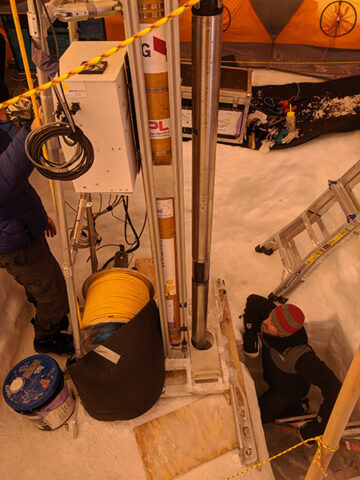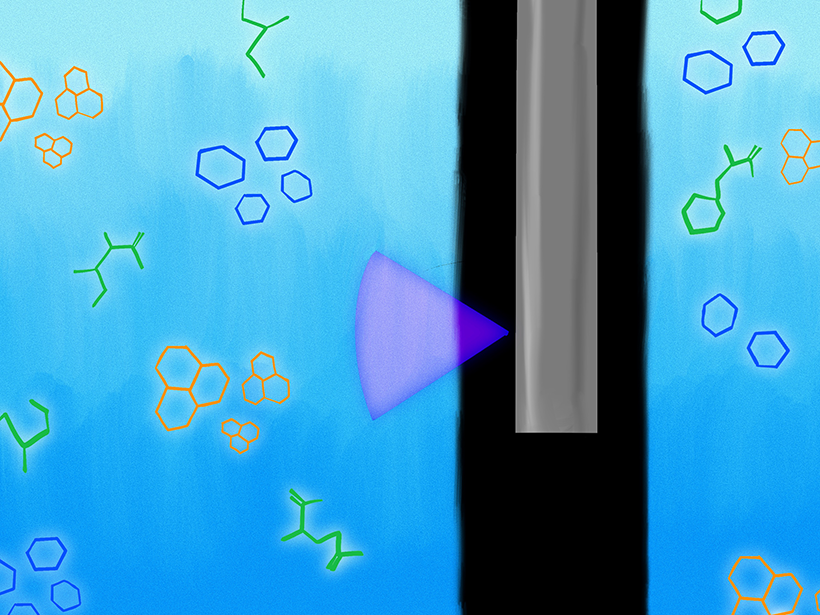
The north winds were a problem. At Summit Station in Greenland, atmospheric scientists depend on the pristine air for atmospheric monitoring, so when the winds blow, any kind of air pollution could interrupt those measurements. And that meant Mike Malaska and his colleagues couldn’t even ride snowmobiles to their research site about 7 kilometers away.
By the time the north winds shifted, the team of three had less than a week to gather their data.
“In terms of actual, hard-core, awesome ‘we’re-getting-data’ science, it was really only about 3 days of really good stuff where everything was just working,” Malaska said. He’s a planetary scientist at NASA’s Jet Propulsion Laboratory (JPL) studying the ice-covered moons in our solar system.

Under a large tent built around a borehole drilled into the ice, Malaska and his team tested an instrument called the Wide Angle Topographic Sensor for Operations and Engineering, or WATSON. WATSON is a long metal tube containing a spectrometer that can detect large, organic molecules in the walls of the borehole.
WATSON was attached to a tripod and lowered into the borehole, scanning the walls to about 100 meters down. Using a technique called ultraviolet fluorescence spectroscopy, WATSON zapped the walls of the borehole with laser beams of ultraviolet light. The UV light excites molecules into higher energy states, and when the molecules drop back to their natural energy states, they release photons. Scientists can then identify specific molecules by detecting the color of the released photons.
Studying this part of an ice sheet is like pointing a telescope to a new area of the sky and discovering new nebulae or galaxies, Malaska said. “We were in this weird environment that nobody had really probed at before.”
Life-Hunting in Ice
Scientists usually study microbes living on the surfaces of glaciers or in deep subglacial lakes kilometers below the surface. A hundred meters down, where water is beginning to transition from packed snow into solid glacial ice, where it may be too cold and the pressure too high for life to survive, research is lacking.
“We shot a laser out, we made things glow, [but] we don’t know exactly what things were glowing.”
WATSON’s spectroscopy may change that. On a black background, Malaska and his team saw spots of glowing blues, greens, and reds, all indicative of different types of organic molecules. Molecules that glowed blue might be small molecular rings called aromatics, and orangey-red spots might be more-complicated molecules like three rings bound together. Greens might indicate something even larger, like amino acids. All of these molecules are associated with living things, but are they evidence of actual microbes in the walls of the borehole? The short answer is…we just don’t know, Malaska said.
“We shot a laser out, we made things glow,” Malaska said, “[but] we don’t know exactly what things were glowing.”
The team published its work in the journal Astrobiology in fall 2020 and will present the research on 11 December at AGU’s Fall Meeting 2020.
From Earth to Enceladus
One day, the WATSON team members hope their instrument could ride on a spacecraft bound for one of the icy moons of Jupiter or Saturn.
With the work in Greenland, the researchers showed that their instrument could successfully find something interesting in the ice, even if they don’t know yet what that interesting thing is. But studying ice on Earth isn’t this team’s main goal. One day, the WATSON team members hope their instrument could ride a spacecraft bound for one of the icy moons of Jupiter or Saturn. Those moons hold vast oceans of liquid water underneath their ice crusts and are considered some of the most promising destinations in the solar system in which to look for extraterrestrial life.
Take Saturn’s moon Enceladus, for example. The tiny moon, with an equatorial radius of just 250 kilometers, became famous in 2006 when NASA’s Cassini spacecraft spotted plumes of water vapor shooting out of its south pole. When the spacecraft eventually flew through those plumes, it found not just water but also chemicals necessary for life: organic molecules, salts, silicates, carbon dioxide, molecular hydrogen, and more. Molecular hydrogen could be evidence for chemical reactions occurring between Enceladus’s ocean and its rocky core that create life-sustaining molecules.
Then there’s Jupiter’s moon Europa, which is much bigger than Enceladus, with an equatorial radius of 1,560 kilometers. Europa most likely also has plumes, according to Hubble Space Telescope observations. NASA is already planning a mission, Europa Clipper (scheduled to launch in 2024), to study the moon. The European Space Agency’s Jupiter Icy Moons Explorer, slated to launch in 2022, will explore Europa, as well as nearby moons Ganymede and Callisto. And someday, NASA might send a lander there.
If these faraway oceans contain enough organic molecules, they could be percolating toward the surface through the ice. And if we drill down far enough, we could detect them with an instrument like WATSON.
If someday deployed on an ocean world, WATSON would be such a useful instrument because it can do the life-hunting in situ, or in the environment in which scientists would be hunting for evidence of life, said Morgan Cable, a planetary scientist also at JPL who specializes in astrobiology. She wasn’t involved with the WATSON research.
“If you can see the microbes in the ice without actually touching them, you can be pretty certain they were in there before you put your probe in there,” Cable said.
WATSON’s Future
“WATSON has the capability of searching for and finding these interesting hot spots” of organic molecules, said Rohit Bhartia, another planetary scientist at JPL and lead researcher on the WATSON team. With an instrument like WATSON attached to a spacecraft on a moon like Enceladus or Europa, scientists could better search for such hot spots.
But building spacecraft and organizing missions, especially to the outer solar system, can take decades. So the WATSON team is spending this time perfecting the instrument by using it to study organic matter in ice here on Earth. Malaska’s hope is to continue using WATSON to find hot spots of organic matter in different icy environments around the globe, and even to return to the Summit Station borehole.
“We [had] only 3 days—we have just enough of a glimpse. I want to know, the stuff we saw at this site—is it the same if I look on the other side of the world? Is it the same a few meters up or a few meters down? There’s, like, a million different things that I could think of doing [with WATSON],” he said, before it ever even leaves Earth’s surface.
—JoAnna Wendel (@JoAnnaScience), Science Writer
Citation:
Wendel, J. (2020), An ice probe on Earth could help us find life in space, Eos, 101, https://doi.org/10.1029/2020EO151887. Published on 10 December 2020.
Text © 2020. The authors. CC BY-NC-ND 3.0
Except where otherwise noted, images are subject to copyright. Any reuse without express permission from the copyright owner is prohibited.

